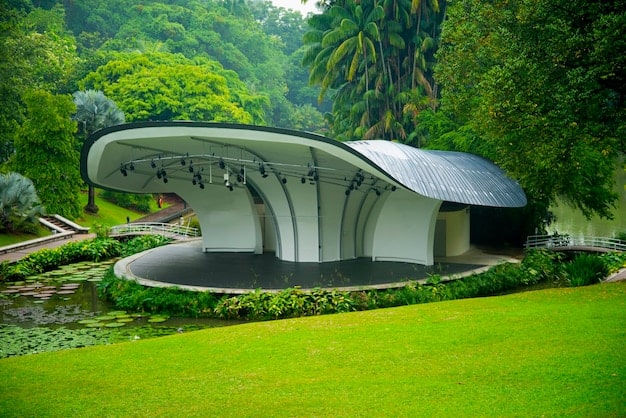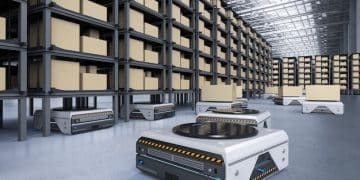Green Infrastructure Tax Credits: A 2025 Guide for US Homeowners

Investing in Green Infrastructure: A Guide to Understanding the New Federal Tax Credits for US Homeowners in 2025 reveals how homeowners can leverage federal tax credits by investing in green infrastructure improvements, such as installing solar panels, energy-efficient windows, and geothermal heating systems, potentially reducing their tax liabilities while contributing to environmental sustainability.
Are you looking to make your home more environmentally friendly while also saving money on your taxes? This comprehensive guide to investing in green infrastructure: A guide to understanding the new federal tax credits for us homeowners in 2025 will help you understand the opportunities available to homeowners like you.
Understanding Green Infrastructure and its Benefits
Green infrastructure refers to the network of natural and semi-natural features designed to provide ecological, social, and economic benefits. It encompasses a wide range of elements, from green roofs and rain gardens to permeable pavements and urban forests. By investing in green infrastructure, homeowners can enhance the value of their property while contributing to the overall health of their community.
What Qualifies as Green Infrastructure?
Several home improvements fall under the umbrella of green infrastructure. These investments help reduce your carbon footprint and lessen strain on local resources. The goal is always environmental and economic well-being.
Benefits for Homeowners
Beyond tax breaks, green infrastructure projects yield a wide range of gains for homeowners. This includes everything from increasing property values and trimming utility bills to improving air quality in your immediate area and local environmental stability.
- Reduced energy consumption and lower utility bills
- Improved air and water quality
- Increased property value
- Enhanced resilience to climate change impacts
Investing in green infrastructure improves not only the value of your property but also the well-being of your surroundings and community.

New Federal Tax Credits for Green Infrastructure: An Overview
The federal government offers various tax credits designed to promote energy efficiency and renewable energy adoption among homeowners. These incentives are slated to become even more significant in 2025, with increased credit amounts and expanded eligibility criteria. Understanding these credits is crucial for homeowners looking to make environmentally conscious upgrades.
Key Tax Credits Available in 2025
Several federal tax credits are potentially available to homeowners. Knowing what they are and how they work is a vital step toward leveraging them in the coming year.
- Residential Clean Energy Credit: Solar, wind, geothermal
- Energy Efficiency Home Improvement Credit: Insulation, windows, doors
These incentives provide substantial financial support for homeowners committed to environmental stewardship.
Navigating the Residential Clean Energy Credit
The Residential Clean Energy Credit is a substantial incentive for homeowners pursuing renewable energy options. Whether you’re considering solar panels, wind turbines, or geothermal heat pumps, this credit can significantly reduce the upfront costs. It’s important to carefully review the specifics to ensure your project qualifies.
Eligible Renewable Energy Systems
This credit covers a wide range of renewable energy systems. Carefully identifying your options is a crucial first step in the process.
Credit Amount and Calculation
The credit amount is based on a percentage of the cost of the eligible system. Knowing the ins and outs of calculating this credit is useful in planning your project and investments this year.
- Calculate total installation costs
- Determine credit-eligible expenses
- Claim appropriate credit during tax filing
Take a look at the rules and guidelines to avoid misclassification.

Maximizing the Energy Efficiency Home Improvement Credit
The Energy Efficiency Home Improvement Credit focuses on upgrades that enhance your home’s energy performance. From insulation improvements to new energy-efficient windows and doors, this credit supports a wide array of projects. It is also important to note the credit limits.
Qualifying Energy-Efficient Upgrades
To be used to its best advantage, carefully identifying which upgrades meet requirements is really useful for homeowners. These can range from new high-performance windows and doors to insulation and roofing.
Understanding Credit Limits and Requirements
There are limits and requirements, and they can be complex. Keep these factors in mind as you work them out.
The Energy Efficiency Home Improvement Credit offers homeowners a pathway to reducing energy consumption and enhancing the overall comfort of their homes.
Step-by-Step Guide to Claiming Your Tax Credits:
You will want to make the process of tax credits as straightforward as possible. By following specific guidance, homeowners can navigate the process with ease and confidence.
Gathering Necessary Documentation
Keep records of all your expenses. Accurate record-keeping and collection of receipts, permits, and certifications are important.
- Invoices
- Permits
- Certifications
Filling Out the Required Tax Forms
Accurately completing the necessary tax forms becomes less stressful when organized documentation is already prepared.
Seeking Professional Assistance
Don’t go it alone. Consider professional insights if the topic has you overwhelmed.
Take a look at seeking professional assistance if you’re worried about something going wrong.
Additional Considerations for Green Infrastructure Projects
Choosing to invest in green initiatives is quite an involved project in itself. Here a few extra guidelines to help you make the most informed decisions.
Evaluating Project Feasibility
The scope of your green improvement project doesn’t have to be determined by the size of your home alone. Your budget and the physical properties around your home will both influence your choices, too.
Working with Qualified Contractors
When undertaking green upgrades and retrofits, be sure to partner with contractors who are adequately certified in environmental construction techniques.
With proper planning and execution, green infrastructure projects can transform your home into an environmentally friendly and financially rewarding asset.
| Key Point | Brief Description |
|---|---|
| ☀️ Solar Panels | Utilize the Residential Clean Energy Credit for solar panel installation. |
| 🏠 Energy Efficiency | Implement home improvements like insulation for tax credits. |
| 💰 Tax Credits | Federal incentives include tax credits like the Clean Energy Credit. |
| ✅ Documentation | Keep thorough records of upgrades and associated costs. |
FAQ
▼
Green infrastructure uses natural systems to manage environmental challenges. These are things designed to absorb stormwater or improve air quality.
▼
The main incentives are the Residential Clean Energy Credit and the Energy Efficiency Home Improvement Credit. These directly support investments.
▼
Projects such as solar, wind, and geothermal often fit the bill. They should come with specific certifications and approvals.
▼
Document everything. You will need receipts, permits, and certifications. Consult a tax professional if the subject is confusing to you.
▼
These incentives may be already available. Speak with a tax professional so that you will not miss out on anything.
Conclusion
Understanding and utilizing federal tax credits for green infrastructure is a smart move for US homeowners in 2025. Taking advantage of these programs allows you to enhance your home’s value while actively supporting environmental sustainability. The incentives not only ease the financial burden of green upgrades but also promote practices that improve your carbon footprint.





